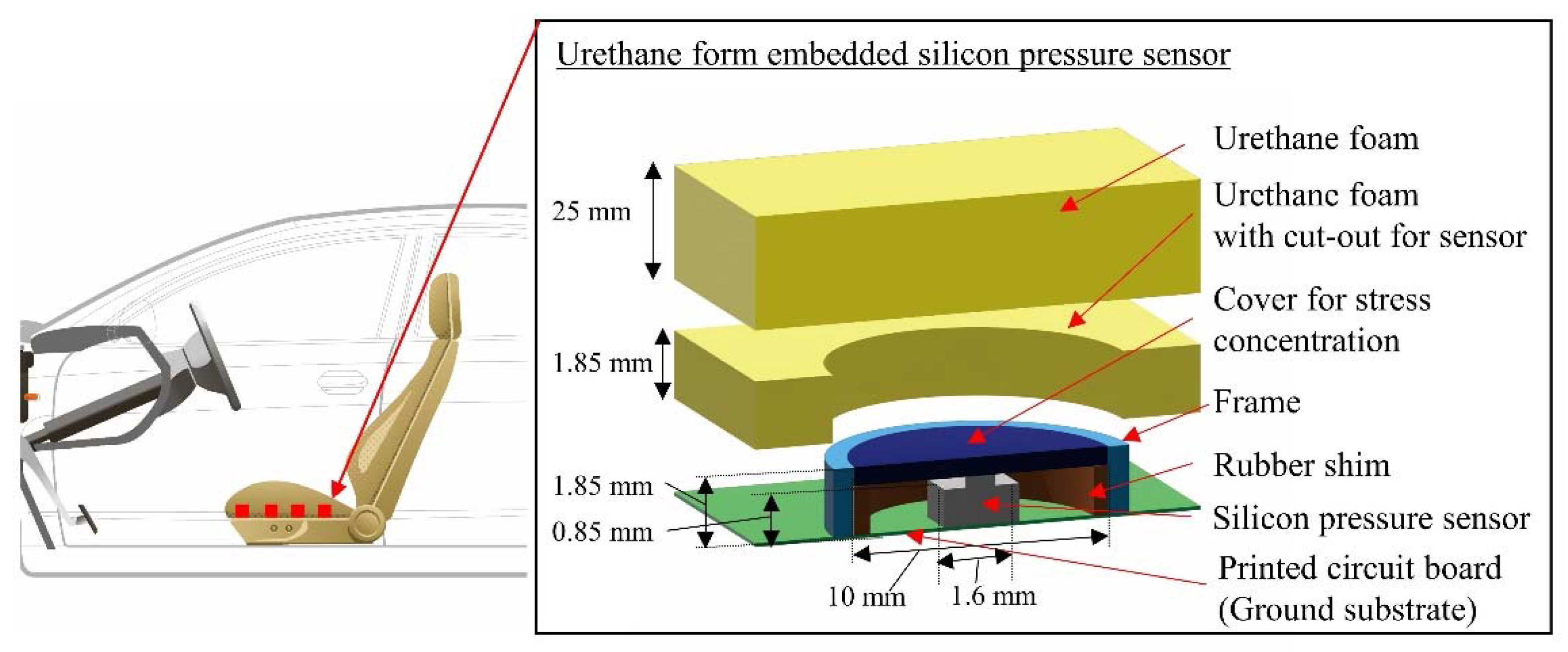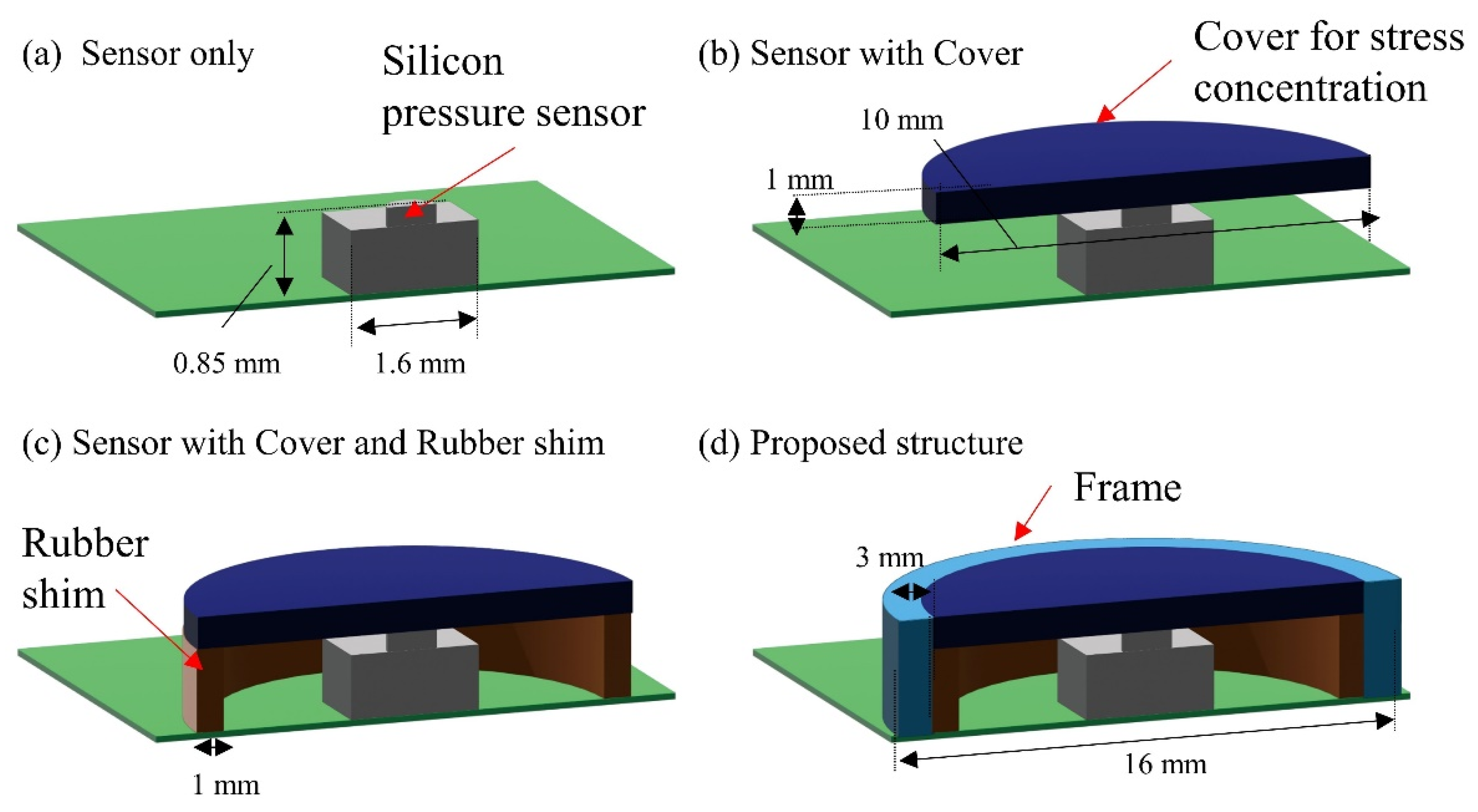Urethane-Foam-Embedded Silicon Pressure Sensors including Stress-Concentration Packaging Structure for Driver Posture Monitoring
Abstract
:1. Introduction
- Avoid discomfort to the driver;
- Avoid interference with cognition, judgment, and automobile operation.
2. Materials and Methods
2.1. Simulations
2.2. Experiments
2.2.1. Proposed Package Structure and Sensor-Array Fabrication
2.2.2. Embedding in Urethane Foam
2.2.3. Pressure-Sensor Evaluation Setup
3. Results
3.1. Simulation and Experimental Results Comparing Four Types of Package Structures
3.2. Optimization of Frame-Structure Width
3.3. Driver Monitoring Demonstration Using Prototype Pressure Sensor Array with Proposed Package
4. Discussion
Author Contributions
Funding
Institutional Review Board Statement
Informed Consent Statement
Data Availability Statement
Conflicts of Interest
References
- Dingus, T.A.; Guo, F.; Lee, S.; Antin, J.F.; Perez, M.; Buchanan-King, M.; Hankey, J. Driver crash risk factors and prevalence evaluation using naturalistic driving data. Proc. Natl. Acad. Sci. USA 2016, 113, 2636–2641. [Google Scholar] [CrossRef] [PubMed] [Green Version]
- Dong, Y.C.; Hu, Z.C.; Uchimura, K.; Murayama, N. Driver Inattention Monitoring System for Intelligent Vehicles: A Review. IEEE Trans. Intell. Transp. Syst. 2011, 12, 596–614. [Google Scholar] [CrossRef]
- Zhao, M.M.; Beurier, G.; Wang, H.Y.; Wang, X.G. Driver posture monitoring in highly automated vehicles using pressure measurement. Traffic Inj. Prev. 2021, 22, 278–283. [Google Scholar] [CrossRef]
- Jimenez, F.; Naranjo, J.E.; Sanchez, S.; Serradilla, F.; Perez, E.; Hernandez, M.J.; Ruiz, T. Communications and Driver Monitoring Aids for Fostering SAE Level-4 Road Vehicles Automation. Electronics 2018, 7, 18. [Google Scholar] [CrossRef] [Green Version]
- Zhang, G.; Yau, K.K.; Zhang, X.; Li, Y. Traffic accidents involving fatigue driving and their extent of casualties. Accid. Anal. Prev. 2016, 87, 34–42. [Google Scholar] [CrossRef] [PubMed]
- Khan, M.Q.; Lee, S. A Comprehensive Survey of Driving Monitoring and Assistance Systems. Sensors 2019, 19, 2574. [Google Scholar] [CrossRef] [PubMed] [Green Version]
- Zhang, C.; Eskandarian, A. A Survey and Tutorial of EEG-Based Brain Monitoring for Driver State Analysis. IEEE/CAA J. Autom. Sin. 2021, 8, 1222–1242. [Google Scholar] [CrossRef]
- Davoli, L.; Martalò, M.; Cilfone, A.; Belli, L.; Ferrari, G.; Presta, R.; Montanari, R.; Mengoni, M.; Giraldi, L.; Amparore, E.G.; et al. On Driver Behavior Recognition for Increased Safety: A Roadmap. Safety 2020, 6, 55. [Google Scholar] [CrossRef]
- Sikander, G.; Anwar, S. Driver Fatigue Detection Systems: A Review. IEEE Trans. Intell. Transp. Syst. 2019, 20, 2339–2352. [Google Scholar] [CrossRef]
- Alioua, N.; Amine, A.; Rogozan, A.; Bensrhair, A.; Rziza, M. Driver head pose estimation using efficient descriptor fusion. EURASIP J. Image Video Process. 2016, 2016, 2. [Google Scholar] [CrossRef] [Green Version]
- Bretzner, L.; Krantz, M. Towards low-cost systems for measuring visual cues of driver fatigue and inattention in automotive applications. In Proceedings of the IEEE International Conference on Vehicular Electronics and Safety (ICVES 2005), Xian, China, 14–16 October 2005; IEEE: Piscataway, NJ, USA, 2005; pp. 161–164. [Google Scholar]
- Liang, W.C.; Yuan, J.; Sun, D.C.; Lin, M.H. Changes in Physiological Parameters Induced by Indoor Simulated Driving: Effect of Lower Body Exercise at Mid-Term Break. Sensors 2009, 9, 6913–6933. [Google Scholar] [CrossRef] [PubMed]
- Tian, R.; Ruan, K.; Li, L.; Le, J.; Greenberg, J.; Barbat, S. Standardized evaluation of camera-based driver state monitoring systems. IEEE/CAA J. Autom. Sin. 2019, 6, 716–732. [Google Scholar] [CrossRef]
- Li, G.; Chung, W.Y. Detection of Driver Drowsiness Using Wavelet Analysis of Heart Rate Variability and a Support Vector Machine Classifier. Sensors 2013, 13, 16494–16511. [Google Scholar] [CrossRef] [PubMed] [Green Version]
- Xing, T.; Wang, Q.; Wu, C.Q.; Xi, W.; Chen, X. dWatch: A Reliable and Low-Power Drowsiness Detection System for Drivers Based on Mobile Devices. ACM Trans. Sens. Netw. 2020, 16, 1–22. [Google Scholar] [CrossRef]
- Tan, H.Z.; Slivovsky, L.A.; Pentland, A. A sensing chair using pressure distribution sensors. EEE/ASME Trans. Mechatron. 2001, 6, 261–268. [Google Scholar] [CrossRef] [Green Version]
- Andreoni, G.; Santambrogio, G.C.; Rabuffetti, M.; Pedotti, A. Method for the analysis of posture and interface pressure of car drivers. Appl. Ergon. 2002, 33, 511–522. [Google Scholar] [CrossRef]
- Lantoine, P.; Lecocq, M.; Bougard, C.; Dousset, E.; Marqueste, T.; Bourdin, C.; Allegre, J.M.; Bauvineau, L.; Mesure, S. Car seat impact on driver’s sitting behavior and perceived discomfort during prolonged real driving on varied road types. PLoS ONE 2021, 16, e0259934. [Google Scholar] [CrossRef]
- Misal, S.; Nair, B.B. A Machine Learning Based Approach to Driver Drowsiness Detection. In Proceedings of the 3rd International Conference on Information, Communication and Computing Technology (ICICCT), New Delhi, India, 12 May 2018; pp. 150–159. [Google Scholar]
- Parsa, M.J.; Javadi, M.; Mazinan, A.H. Fatigue level detection using multivariate autoregressive exogenous nonlinear modeling based on driver body pressure distribution. Proc. Inst. Mech. Eng. Part D J. Automob. Eng. 2022, 236, 168–184. [Google Scholar] [CrossRef]
- Arippa, F.; Leban, B.; Fadda, P.; Fancello, G.; Pau, M. Trunk sway changes in professional bus drivers during actual shifts on long-distance routes. Ergonomics 2021, 65, 762–774. [Google Scholar] [CrossRef]
- Murata, A.; Kite, I.; Karwowski, W. Assessment of Driver’s Drowsiness Based on Fractal Dimensional Analysis of Sitting and Back Pressure Measurements. Front. Psychol. 2018, 9, 2362. [Google Scholar] [CrossRef]
- Kumar, R.P.; Melcher, D.; Buttolo, P.; Jia, Y. Monitoring of Occupant States in Autonomous Vehicles Using Capacitance-Sensing Imaging. IEEE Sens. J. 2020, 20, 12914–12927. [Google Scholar] [CrossRef]
- Ding, M.; Suzuki, T.; Ogasawara, T. Estimation of Driver’s Posture using Pressure Distribution Sensors in Driving Simulator and On-Road Experiment. In Proceedings of the IEEE International Conference on Cyborg and Bionic Systems (CBS), Beijing, China, 17–19 October 2017; pp. 215–220. [Google Scholar]
- Rusch, K.C. Load-Compression Behavior of Flexible Foams. J. Appl. Polym. Sci. 1969, 13, 2297. [Google Scholar] [CrossRef]
- Ashby, M.F. The Mechanical-Properties of Cellular Solids. Metall. Trans. A Phys. Metall. Mater. Sci. 1983, 14, 1755–1769. [Google Scholar] [CrossRef]
- Briody, C.; Duignan, B.; Jerrams, S.; Tiernan, J. The implementation of a visco-hyperelastic numerical material model for simulating the behaviour of polymer foam materials. Comput. Mater. Sci. 2012, 64, 47–51. [Google Scholar] [CrossRef] [Green Version]
- Twizell, E.H.; Ogden, R.W. Non-Linear Optimization of the Material Constants in Ogden Stress-Deformation Function for Incompressible Isotropic Elastic-Materials. J. Aust. Math. Soc. Ser. B Appl. Math. 1983, 24, 424–434. [Google Scholar] [CrossRef] [Green Version]








| Sitting on the Seat | Swaying the Body Left and Right | Swaying the Body Back and Forth | ||
|---|---|---|---|---|
| Right | Left | Forward | Back | |
| 0.878 | 0.969 | 0.994 | 0.903 | 0.934 |
Publisher’s Note: MDPI stays neutral with regard to jurisdictional claims in published maps and institutional affiliations. |
© 2022 by the authors. Licensee MDPI, Basel, Switzerland. This article is an open access article distributed under the terms and conditions of the Creative Commons Attribution (CC BY) license (https://creativecommons.org/licenses/by/4.0/).
Share and Cite
Takamatsu, S.; Sato, S.; Itoh, T. Urethane-Foam-Embedded Silicon Pressure Sensors including Stress-Concentration Packaging Structure for Driver Posture Monitoring. Sensors 2022, 22, 4495. https://doi.org/10.3390/s22124495
Takamatsu S, Sato S, Itoh T. Urethane-Foam-Embedded Silicon Pressure Sensors including Stress-Concentration Packaging Structure for Driver Posture Monitoring. Sensors. 2022; 22(12):4495. https://doi.org/10.3390/s22124495
Chicago/Turabian StyleTakamatsu, Seiichi, Suguru Sato, and Toshihiro Itoh. 2022. "Urethane-Foam-Embedded Silicon Pressure Sensors including Stress-Concentration Packaging Structure for Driver Posture Monitoring" Sensors 22, no. 12: 4495. https://doi.org/10.3390/s22124495
APA StyleTakamatsu, S., Sato, S., & Itoh, T. (2022). Urethane-Foam-Embedded Silicon Pressure Sensors including Stress-Concentration Packaging Structure for Driver Posture Monitoring. Sensors, 22(12), 4495. https://doi.org/10.3390/s22124495






